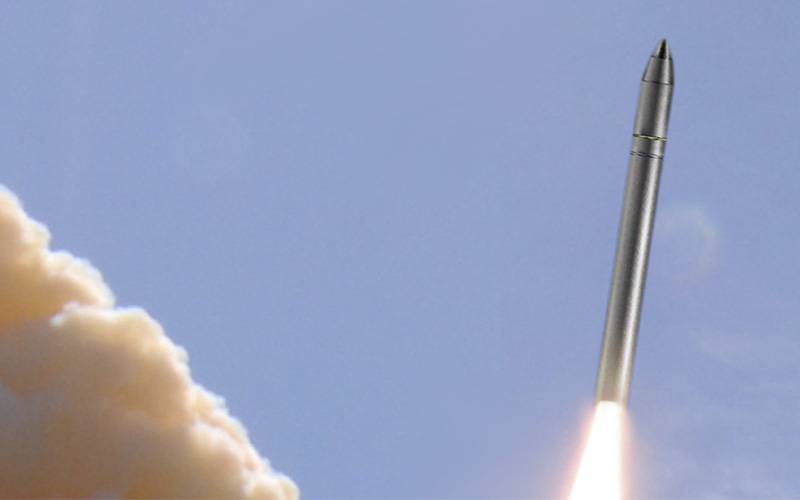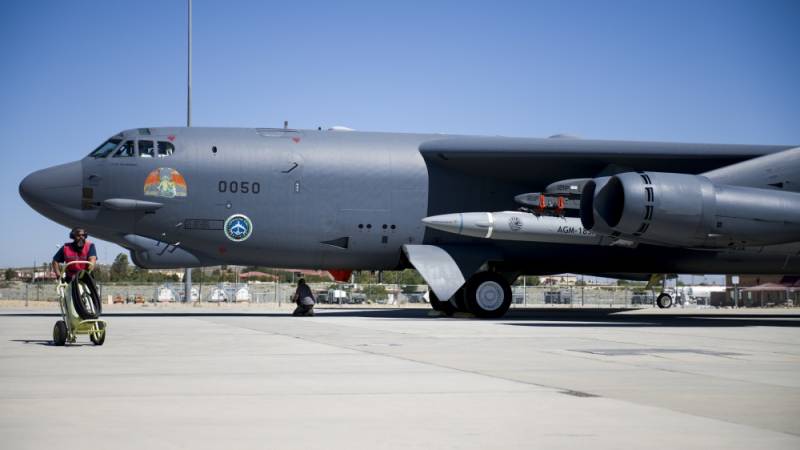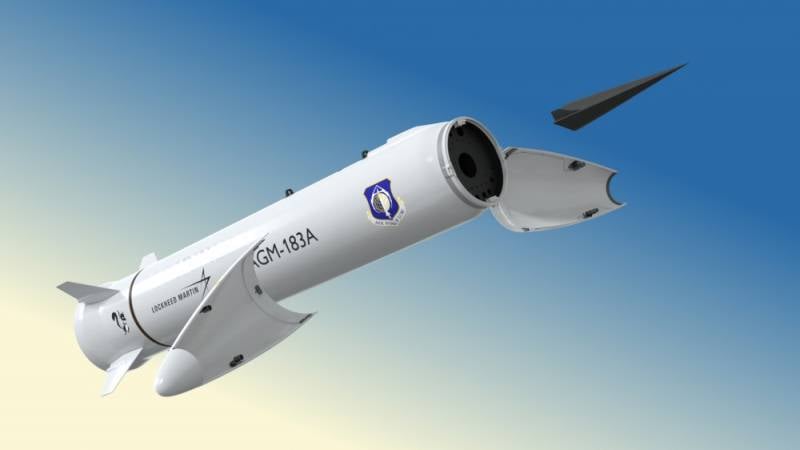"Avangard" in American style. Hypersonic gliding unit for GBSD

The alleged appearance of the GBSD rocket. Northrop Grumman Graphics
The Pentagon is actively engaged in the topic of hypersonic weapons in the interests of different types of armed forces, incl. Air Force. Recently it became known that the Air Force in the future may receive another missile system with hypersonic combat equipment: it will be carried out on the basis of the GBSD intercontinental ballistic missile, which is still in the early stages of development.
For administrative use
In December last year, Northrop Grumman was announced the winner of the tender for the development of a promising Ground Based Strategic Deterrent (GBSD) ICBM. By that time, some of the customer's requirements in the person of the Air Force were known, and soon new details appeared. In particular, they talked about the need to create a rocket complex with a modular architecture, which should simplify operation and expand the range of tasks to be solved.
On August 12, the Air Force Nuclear Weapons Center (AFNWC) posted a technology information request for the GBSD program on the public procurement website. It is curious that the document had the U / FOUO stamp - "unclassified, only for official use" and was not subject to publication on open resources. The request did not go unnoticed by the specialized press.
However, on August 17, after increased media interest, the classified document was removed from the public domain. Why it turned out to be available not only to a narrow circle of individuals and organizations was not specified.
Seven points
The document stipulates the desire of AFNWC to work out several directions for the development of the modular architecture of the future ICBM. One of them is "a thermal protection system capable of providing hypersonic flight over an intercontinental range." Obvious conclusions follow from this definition: in the context of GBSD, they are going to work out the issues of creating and implementing hypersonic gliding warheads.
Earlier in the messages about the GBSD program, only "traditional" combat equipment in the form of individual guidance units was mentioned. Now it turns out that the rocket can have a modular payload - and carry a hypersonic glider.
The desired characteristics of a missile system with such combat equipment, apparently, have not yet been fully determined - only the intercontinental range was indicated in the request. In this regard, the wishes of AFNWC regarding accuracy, type of warhead, etc. remain unknown.
Nuclear problem
According to open data, the GBSD ICBM will receive a multiple warhead with individual guidance units. Thermonuclear warheads W87 Mod 1 will be used - the latest modification of a fairly old product used on several types of American ICBMs. In this configuration, the GBSD will be a typical modern ICBM capable of solving strategic deterrence tasks.
The same tasks are assigned to an ICBM with a hypersonic unit, and therefore it also needs a nuclear charge. However, this architecture of the missile system has not yet been confirmed. In addition, it does not correspond to the stated goals and objectives of the American hypersonic program in their current form.
In the recent past, Pentagon officials in charge of promising areas have repeatedly said that hypersonic complexes will not be equipped with nuclear warheads. Such systems, regardless of range and architecture, will carry only conventional ammunition, and this is the principled position of the military department.
As follows from recent messages and publications, the Pentagon has not changed its views on equipping hypersonic units. Apparently, this version of the GBSD ICBM may indeed be non-nuclear - if it manages to go beyond the preliminary research stage.
Second remedy
Currently, in the interests of the US armed forces, several hypersonic missile systems are being developed with different capabilities and tasks. For the Air Force, only one such sample is being created, and it has already been brought to the first tests. In the future, the GBSD intercontinental missile with a glider on board may become the second in this row.
In the middle of last year, the Air Force began aerodynamic tests of the advanced hypersonic aeroballistic missile AGM-183A Air-Launched Rapid Response Weapon (ARRW) developed by Lockheed Martin. The mock-up of the product was taken out under the wing of a carrier bomber to determine some characteristics. The last flight of this kind took place a few weeks ago. This concludes the export tests and full launches are expected.
Flight tests are expected to take place in 2021-22. with the arrival of the rocket into service in 2023. Four items ordered in full configuration. Half is used for tests, and the rest will then be handed over to the customer. Full-scale serial production and implementation in the Air Force will begin only by the middle of the decade.
The AGM-183A is a single-stage solid-propellant rocket equipped with a Tactical Boost Glide (TBG) jettisonable hypersonic glider. The latter, according to various sources, can develop a speed of M = 20. There are speculations according to which TBG will receive nuclear weapons, but this is not confirmed by official sources - and contradicts the stated position of the Pentagon.
Plans and opportunities
No earlier than 2023, the US Air Force will receive the latest airborne hypersonic missile system ARRW. It is intended for use on strategic aircraft aviation - B-52H, B-2A and B-21. Then, in 2027, the deployment of the GBSD intercontinental complex will begin, which may also receive hypersonic equipment.
If the situation develops in this way, then by the end of the twenties the Air Force will have at once two hypersonic missile systems of fundamentally different classes, but suitable for use in the strategic deterrence system. At the same time, it is quite possible that the existing views of the Pentagon will remain in force, and both of these means will relate to non-nuclear weapons.
Depending on the mission, the Air Force will be able to send bombers with aeroballistic missiles or ICBMs with special equipment to the target. In both cases, such a strike will be extremely dangerous for a potential enemy due to the special characteristics and capabilities of hypersonic warheads. Consequently, the strike potential of strategic aviation and missile formations will grow significantly.
However, not everything is so simple. The development of the ARRW and TBG projects gives some reason for optimism, although finished products will appear in the troops only in a few years. The future of the basic GBSD project is also being considered in a positive way, but the hypersonic modification of this rocket is still in question.
The deployment and use of GBSDs in non-nuclear combat equipment are facing serious difficulties. Any launch of ICBMs attracts the attention of third countries, and combat use against a real target will provoke a response. In some cases, this can lead to a rapid escalation of the conflict, up to full-fledged nuclear strikes. All this sharply reduces the potential of the complex and actually deprives it of its advantages over nuclear-equipped ICBMs.
"Avangard" in American style
It should be noted that at the level of the basic concept, the promising modification of the GBSD product is similar to the Russian project "Avangard". It provides for equipping ICBMs with a hypersonic gliding unit. The type of charge on the block is still unknown. At the same time, it is obvious that the Avangard with a nuclear weapon on board is becoming an extremely dangerous weapon. Whether the American development will be able to repeat these successes is unknown. It is noteworthy that the Russian complex has already entered service, ahead of the hypothetical American development by many years.
In the near future, the Air Force Nuclear Weapons Center, scientific organizations and contractor companies will have to work out a variant of equipping ICBMs with a hypersonic warhead with certain characteristics, and determine its need for the Air Force. It is possible that such a project will be considered necessary, but another outcome cannot be ruled out. Whether the US Air Force will receive its analogue of the Avangard will become clear in a few years.



Information